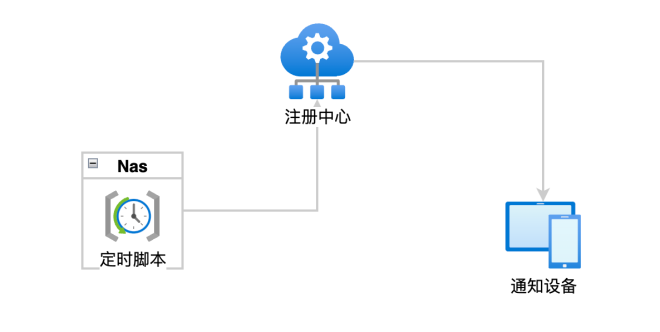
日常使用NAS过程中,偶尔会出现家里断电或者断网的情况,NAS自带网络断开的通知功能,但需要是恢复网络链接后才会通知,而此时都恢复了,再通知也就没那么重要,还有断电情况下也是需要回家才能知道,断电保护可以使用UPS,当停电后UPS通过usb数据线会给NAS发送通知,NAS收到通知后在设定时间内关机并发送ups进入电池供电模式的通知,但这个方式需要购买ups设备,成本在300元左右。

注册中心原理
联想到注册中心等其他集群模式下的心跳连接,心跳超时则进行剔除的方式,自己便用python写了一个简单的web服务当作注册中心,再写一个定时任务每隔5秒扫描一遍最近注册时间数据,对比下来如果超时60秒以上,则认为NAS已经失去链接,立刻发送邮件/钉钉通知,当NAS重新上线连接后,定时任务扫描到注册信息会再发送已经连接的通知信息。
NAS端原理
上文已经通过python提供了一个web服务,此时只需要在NAS端任务计划中创建一个每分钟的定时任务即可,定时请求心跳接口,服务端记录请求时间。

或者在docker里启动一个定时任务,crontab命令
|
1 2 |
service cron start */1 * * * * curl http://ip:2580/register |
服务端代码
启动python的命令,需要在后台运行
|
1 2 3 |
ps -ef|grep python nohup python3 nas_health.py & nohup python3 nas_register.py & |
nas_register-类似于注册中心的概念,提供一个get接口供NAS访问
|
1 2 3 4 5 6 7 8 9 10 11 12 13 14 15 16 17 18 19 20 21 22 23 24 25 26 27 |
# -*- encoding: utf-8 -*- import os import datetime import tornado.web class MainHandler(tornado.web.RequestHandler): def get(self): """get请求""" now = datetime.datetime.now() out = open("nas_datetime-" + str(now.year) + '-' + str(now.month) + '-' + str(now.day), 'a') out.write(str(now) + '\n') out.close() self.write("") application = tornado.web.Application([(r"/register", MainHandler)], static_path=os.path.join(os.path.dirname(__file__), "static"), ) # 读取文件中的数据 def read_txt_file(file_name): newFile = open(file_name) data = newFile.read() newFile.close() return data if __name__ == "__main__": application.listen(2580) tornado.ioloop.IOLoop.instance().start() |
nas_health-定时扫描日志文件,对比注册时间
|
1 2 3 4 5 6 7 8 9 10 11 12 13 14 15 16 17 18 19 20 21 22 23 24 25 26 27 28 29 30 31 32 33 34 35 36 37 38 39 40 41 42 43 44 45 46 47 48 49 50 51 52 53 54 55 56 57 58 59 60 61 62 |
# -*- encoding: utf-8 -*- import datetime import time import smtplib from email.mime.text import MIMEText from email.header import Header # 读取文件中的数据 def read_txt_file(file_name): newFile = open(file_name) data = newFile.read() if data == '': return '' now = '' for line in data.split('\n'): if line == '': break now = line newFile.close() return now def loop_monitor(): email_state = True while True: try: file_now = datetime.datetime.now() now_str = read_txt_file( "nas_datetime-" + str(file_now.year) + '-' + str(file_now.month) + '-' + str(file_now.day)) if now_str == '': continue now = datetime.datetime.strptime(str(now_str), "%Y-%m-%d %H:%M:%S.%f") now2 = datetime.datetime.now() print((now2 - now).seconds) if (now2 - now).seconds >= 60 and email_state: email("心跳已经超时", "xxx@xxx.com") email_state = False if (now2 - now).seconds < 60 and email_state == False: email_state = True email("心跳已经恢复", "xxx@xxx.com") except Exception as e: print("时间错误", e) time.sleep(5) # 暂停5秒 def email(text, toemail): sender = "xxx@xxx.com" # 发送方的邮箱 password = "xxxx." # 邮箱的授权码 receiver = toemail # 接收方的邮箱 data_time = time.strftime("%Y-%m-%d %H:%M:%S") subject = data_time + "Nas服务器心跳报警" # title邮件标题 words = text # text邮件内容 msg = MIMEText(words, 'plain', 'utf-8') # 中文需参数‘utf-8',单字节字符不需要 msg['Subject'] = Header(subject, 'utf-8') # 邮件标题 msg['from'] = sender # 发信人地址 msg['to'] = receiver # 收信人地址 smtp = smtplib.SMTP_SSL("smtp.exmail.qq.com", 465) smtp.connect('smtp.exmail.qq.com') smtp.login(sender, password) smtp.sendmail(sender, receiver, msg.as_string()) smtp.quit() if __name__ == "__main__": loop_monitor() |
